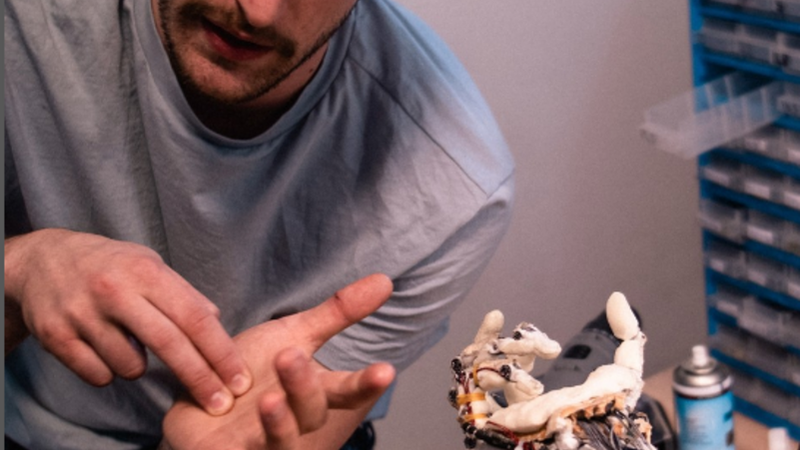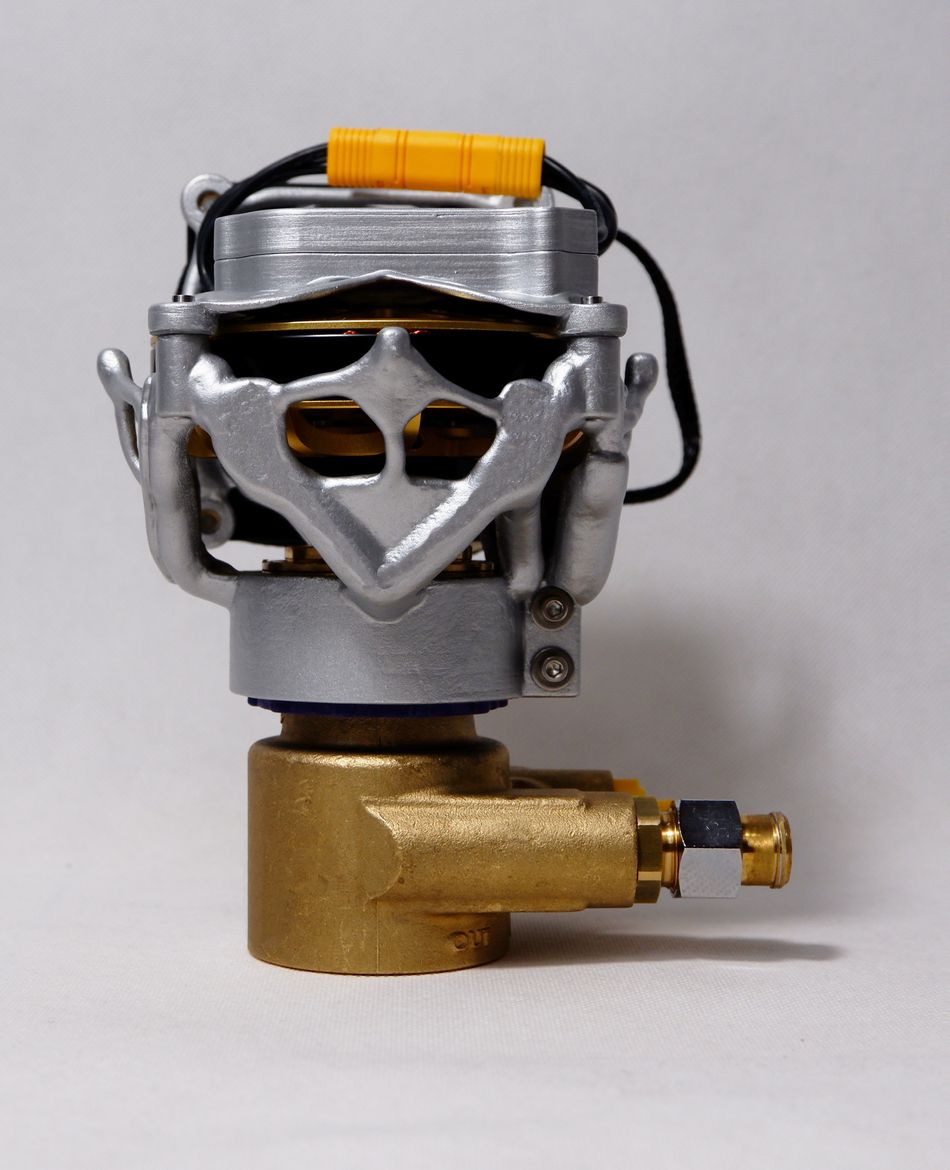Could this lifelike robotic hand be the start of a humanoid future?
Clone Robotics’ humanoid hand uses hydraulics to mimic complex human hand function.

Image credit: Clone Robotics
Imagine a world where workers delegate arduous tasks to humanoid robots that can mimic human activity.. I’ll take it one step further. Imagine a world where every person has their own android that observes and fulfils their every wish. This may sound a little far-fetched or too science fiction-y, but believe it or not, we are witnessing the beginning of this transformation; and it all starts with mimicking the human hand.
Our world is built for human hands. We have designed a world of tools and objects to be purposefully used and controlled by the human hand. Think of activities like grabbing an object firmly and picking it up steadily, such as holding a pen to write, a cup of coffee to drink, a screwdriver to turn screws, or a smartphone to type on. As simple and mundane as these activities may seem, they are, in fact, utilising a system of fingers and joints that follow a complex mechanism of up to 27 degrees of freedom. That means there are 27 independent movements that work conjunctly to perform those so-called ‘simple’ activities.
Mimicking the human hand would require following a similar mechanism with the same number of degrees of freedom. This has been no easy challenge, at least until a company called Clone Robotics set off earlier this year to develop the Clone Hand. It is a biomimetic, robotic hand that looks like a human hand, moves like a human hand, and is built like a human hand - only from artificial materials. It is a mesmerising thing to see, especially with the strength and capabilities it has shown.
But how realistic is this? Why and where do we need such technology? And how did Clone Robotics create the Clone Hand?
Humanoids are nevitable, and the hand is the starting point
A humanoid - or a human-looking android - is a robot with an anthropomorphic body. Over the years, robots have taken so many different forms, but it is the humanoid that first comes to mind whenever we think of robots.
One reason is that we have always imagined how we communicate with a robot to be similar to communicating with humans. But more realistically, the major advantage is that robots can operate and navigate in an environment originally designed for humans. This minimises risk upon humans as robots would take over harsh tasks in potentially hazardous environments, such as chemical plants, nuclear waste facilities, wet labs, and space stations. In addition, mundane tasks with minimal added value to humans can be assigned to humanoids, as they can execute them consistently and efficiently, leaving humans to focus on rather creative and desirable activities.
Since work environments have been designed for humans, the primary bodily part to consider in humanoids is the hand. “The hand is one of the most complex and beautiful pieces of natural engineering in the human body,” said Dr George McGavin in his 2014 BBC article. “It gives us a powerful grip but also allows us to manipulate small objects with great precision.”
The human hand has over 30 muscles, 123 ligaments, and 27 bones that enable it to handle complex tasks. But, surprisingly enough, there are no muscles in the fingers that induce movement. The finger movement is controlled by muscles and tendons in the forearm and palm.
So, with all that complexity, how can a robotic hand mimic the human hand?
Creating an artificial clone of the human hand
When you hear of a robotic hand or robotic arm, you might think of a rigid, metallic structure with a handful of joints and beams. Clone Robotics has taken a different approach and produced an engineering marvel that looks eerily similar to a human hand.
In early 2022, Clone Robotics set out to create what they called “the final missing piece of robotic hardware needed to build intelligent androids,” - the hand. It is the world’s first biomimetic hand that is able to grab, with the grip of a human hand, objects like a tennis ball, a plastic bottle, a saw, an apothecary flask, a kettlebell, and even an active drill machine.
Hydraulic Artificial Muscles (PAMs)
Based on years of testing and R&D, Clone perfected the McKibben muscle, a hydraulic artificial muscle (HAM) technology. HAMs are soft, lightweight, and flexible structures that contract or expand based on their inner waterflow to generate human-muscle-like actuation. Clone’s proprietary artificial muscles are sturdy against external disturbances and can withstand heavy loads. The Clone Hand (Model V15) has a total of 36 HAMs made of sustainable, cost-effective material.
Skeleton with 27 degrees of freedom
The hydraulic artificial muscles support and control a skeleton of jointed artificial bones resembling human bones, delivering a mechanism of 27 degrees of freedom, just like a human hand. In other words, the Clone hand’s wrist, thumb and fingers can move, turn, fold, and grab in a similar way to how our fingers do. Those bones are made of recyclable, cheap composite material that Clone claims to manufacture in-house.
Lightweight hydraulic power supply
The muscles are driven by a portable hydraulic power supply, carrying a water vane pump that delivers a volume flow rate of up to 400 litres per hour at about ten times the atmospheric pressure via the help of a 500W motor. Muscles are controlled by 36 electro-hydraulic valves to direct the flow and pressure sensors for data feedback and flow control.
robotics
Portable system
Clone Robotics states that the whole Hand system fits into a 46x33x16 cm suitcase at a maximum weight of 6kg. This system includes:
- The Clone Hand
- The hydraulic power supply
- 36 electro-hydraulic valves
- A 180W/h battery pack
- An 8GB Raspberry PI 4B computer
The table below summarises all the distinct characteristics of the Clone Hand:
Clone Hand Characteristics | |
Pneumatic Artificial Muscles | Over 650 000 cycles with 1kg load |
27.5% contraction under 1kg load | |
0.3s full contraction time under 1kg load | |
27 Degrees of Freedom | Thumb rotation |
Fingers from left to right | |
Wrist movements | |
Natural pronation and supination of forearm | |
Locked elbow joint | |
Hydraulic Power Supply + Valve System | 500W BLDC motor |
400L/h at 10 bar | |
Flexible reservoir for 0.5L of purified water | |
Total weight of 4.3 kg | |
36 electro-hydraulic valves weighing 24g each | |
36 pressure sensors for strength and flow control | |
What’s next for Clone?
The development of a robotic hand that mimics the human hand has the potential to revolutionize the way we interact with technology. With the ability to perform tasks with the same dexterity and precision as a human hand, the Clone hand has the potential to instigate a transformation in manufacturing, healthcare, and even everyday tasks.
For more information on the Clone Hand, visit the Clone Robotics website.

